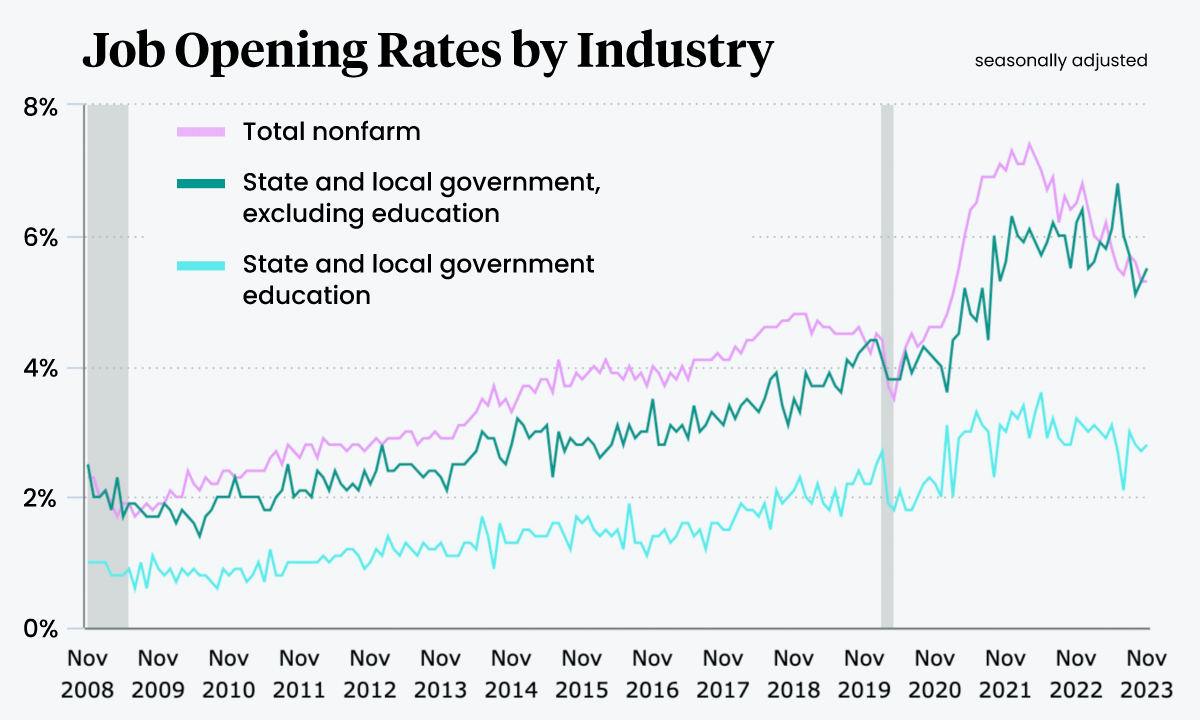With 160,000 Jobs Added in 2023, the State of the Education Workforce Is Strong
Aldeman: Federal economic data show that at 2.8%, public education has the lowest job opening rate of all major industries.

Get stories like these delivered straight to your inbox. Sign up for The 74 Newsletter
2023 was another good year for employment in public education.
According to the latest data from the Bureau of Labor Statistics, public K-12 schools added 160,000 jobs last year. Coming on the heels of big gains in 2021 and 2022, the country has now had the biggest three-year gain since the mid-1970s.
Of course, 2020 was a historically bad year, and schools still aren’t fully back to their pre-pandemic employment highs. But they’re close. Meanwhile, student enrollment is down, with further declines on the horizon, which means staffing levels per student continue to fall.
With all this hiring, there’s been a lot of attention to the number of people that schools would like to bring on. That number has gone up as schools look to replace employees who leave, while trying to hire new tutors, mental health counselors and other staff.
But it’s worth putting public education’s hiring challenges in the context of other sectors in the economy. In the Bureau of Labor Statistics chart below, each line represents a major industry. The data lump all of public education together under “state and local government education.” That group (in turquoise in the graph) includes both K-12 and higher ed.
As the chart shows, all the lines have gone up over time — meaning all employers are struggling to fill their job openings. But public education regularly has the lowest job opening rate among all major industries.

In percentage terms, as of the latest data in November, public education employers had a job opening rate of 2.8%, the lowest on the chart. That means, for every 100 employees, schools were trying to hire 2.8 more. In comparison, the private sector as a whole had job opening rates twice as high. So did other state and local government employers.
These data are seasonally adjusted, which helps to smooth out things like the large number of cashiers and delivery drivers hired by retailers in the weeks leading up to the December holidays.
The seasonally adjusted data are better for comparing across industries, but there is one time of year where schools hire at similar levels as other employers, and that’s the back-to-school rush. Every summer, K-12 schools “lose” about 1.5 million workers, including teachers, aides, bus drivers and other staff, only to rehire the same number of employees back in the fall.
This makes the fall hiring season especially chaotic. The graph below shows the raw, non-seasonally adjusted hiring rate for public education by month; August is the one time of year when these employers go into full-on hiring mode.
We’re now in a moment of relative calm. Job opening and hiring rates are both trending downward as the market cools, and that’s likely to continue as school districts spend down their remaining federal ESSER funds.
As noted at the beginning, the big hiring numbers over the last few years have more than made up for elevated rates of employee departures. But turnover rates also seem to be coming down.
For example, after a historic high in teacher turnover in 2022, new data out of Arkansas, Florida, North Carolina and South Carolina all show teacher turnover rates were down slightly in 2023.
There are other signs of progress in the education labor market as well. A RAND survey over the summer found teacher stress and anxiety levels were back to pre-pandemic levels. After years of slow progress, the teacher workforce diversified rapidly during the last few years, fueled in part by temporary waivers of state licensure requirements. And the latest national data show that teacher salaries finally outpaced inflation after a few years of lagging behind.
In other words, 2023 was a year of progress for the American education workforce. That should be welcome news after a tumultuous time.
Get stories like these delivered straight to your inbox. Sign up for The 74 Newsletter


